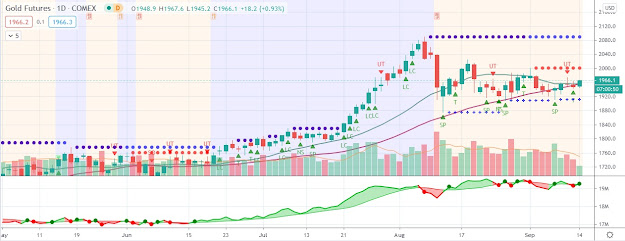Gold could drop below $1,300 in December
Much of the commodity strength, and dollar weakness, of recent weeks comes from expectations of further quantitative easing (dubbed “QE II”) by the Fed. Just how much of this is already
priced in will be key for commodities, gold in particular. We use gold’s strong causal relationship with global liquidity to estimate how much QE the gold market is already pricing in.
 Empirically, we find the long-term causal drivers of gold are global liquidity and real interest rates. We define global liquidity as the Fed’s balance sheet plus global foreign reserve holdings (excluding gold). Gold trades around the long term trend these two variables provide. All other factors are short term drivers. Lately, gold has diverged by some margin from the long-term trend provided by these causal drivers. Divergence by gold from this long-term trend is not unusual, but the speed, size and timing of its divergence coincide with the increasing expectations for further QE. We find that:
Empirically, we find the long-term causal drivers of gold are global liquidity and real interest rates. We define global liquidity as the Fed’s balance sheet plus global foreign reserve holdings (excluding gold). Gold trades around the long term trend these two variables provide. All other factors are short term drivers. Lately, gold has diverged by some margin from the long-term trend provided by these causal drivers. Divergence by gold from this long-term trend is not unusual, but the speed, size and timing of its divergence coincide with the increasing expectations for further QE. We find that:
With our belief that gold is pricing in substantial QE already, combined with the fact that scrap continues to come to the market at the current gold price, a conservative approach on QE by the Fed could see gold drop below $1,300 in November. This may be amplified by seasonal jewellery demand (which we expect to decline in the December).
While we remain bullish on gold into 2011, we could even see gold at $1,260 - a point at which major technical support lies.
priced in will be key for commodities, gold in particular. We use gold’s strong causal relationship with global liquidity to estimate how much QE the gold market is already pricing in.
 Empirically, we find the long-term causal drivers of gold are global liquidity and real interest rates. We define global liquidity as the Fed’s balance sheet plus global foreign reserve holdings (excluding gold). Gold trades around the long term trend these two variables provide. All other factors are short term drivers. Lately, gold has diverged by some margin from the long-term trend provided by these causal drivers. Divergence by gold from this long-term trend is not unusual, but the speed, size and timing of its divergence coincide with the increasing expectations for further QE. We find that:
Empirically, we find the long-term causal drivers of gold are global liquidity and real interest rates. We define global liquidity as the Fed’s balance sheet plus global foreign reserve holdings (excluding gold). Gold trades around the long term trend these two variables provide. All other factors are short term drivers. Lately, gold has diverged by some margin from the long-term trend provided by these causal drivers. Divergence by gold from this long-term trend is not unusual, but the speed, size and timing of its divergence coincide with the increasing expectations for further QE. We find that:- Firstly, for global liquidity to be consistent with the current gold price around $1,350, the Fed would have to expand its balance sheet by $500bn.
- Secondly, a gold price closer to $1,280 would be consistent with the Fed announcing no further QE.
- Thirdly, should the Fed provide $1trn in additional QE, a gold price closer to $1,400 should follow.
With our belief that gold is pricing in substantial QE already, combined with the fact that scrap continues to come to the market at the current gold price, a conservative approach on QE by the Fed could see gold drop below $1,300 in November. This may be amplified by seasonal jewellery demand (which we expect to decline in the December).
While we remain bullish on gold into 2011, we could even see gold at $1,260 - a point at which major technical support lies.



Comments
Post a Comment